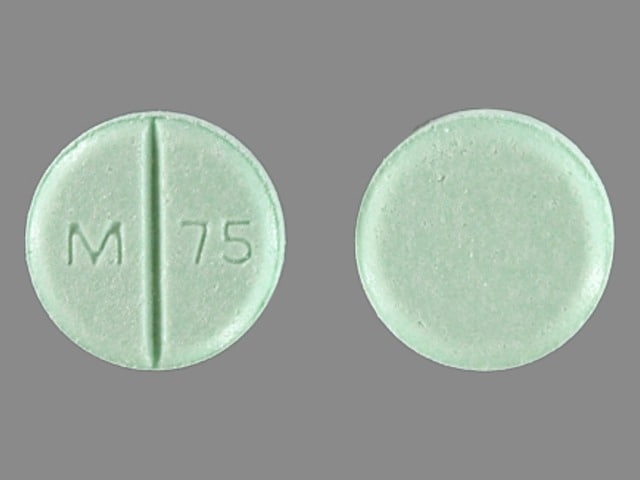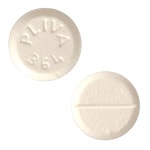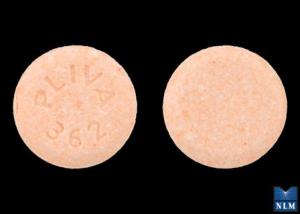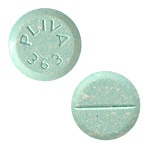Dosage Forms
Excipient information presented when available (limited, particularly for generics); consult specific product labeling.
Tablet, Oral:
Generic: 25 mg, 50 mg
Pharmacology
Mechanism of Action
Sulfonamide-derived diuretic that inhibits sodium and chloride reabsorption in the distal convoluted tubule (Gamba 2005; Moes 2014; Rose 1991).
Pharmacokinetics/Pharmacodynamics
Metabolism
Hepatic
Excretion
Urine (primarily as unchanged drug)
Onset of Action
~2.6 hours; Peak effect: 2 to 6 hours (Carter 2004)
Duration of Action
Single dose: 24 to 48 hours; Long-term dosing: 48 to 72 hours (Carter 2004)
Half-Life Elimination
Single dose: 40 hours; Long-term dosing: 45 to 60 hours (Carter 2004); may be prolonged with renal impairment
Protein Binding
~75% (58% to albumin)
Use: Labeled Indications
Edema: Adjunctive treatment of edema associated with heart failure, renal impairment, hepatic cirrhosis, or corticosteroid and estrogen therapy.
Hypertension: Management of hypertension.
Guideline recommendations: The 2017 Guideline for the Prevention, Detection, Evaluation, and Management of High Blood Pressure in Adults recommends if monotherapy is warranted, in the absence of comorbidities (eg, cerebrovascular disease, chronic kidney disease, diabetes, heart failure, ischemic heart disease, etc), that thiazide-like diuretics or dihydropyridine calcium channel blockers may be preferred options due to improved cardiovascular endpoints (eg, prevention of heart failure and stroke). ACE inhibitors and ARBs are also acceptable for monotherapy. Combination therapy may be required to achieve blood pressure goals and is initially preferred in patients at high risk (stage 2 hypertension or atherosclerotic cardiovascular disease [ASCVD] risk ≥10%) (ACC/AHA [Whelton 2017]).
Use: Off Label
Calcium nephrolithiasisbyes
Data from a prospective, double-blind, randomized, placebo-controlled study support the use of chlorthalidone for the prevention of recurrent calcium nephrolithiasis Ettinger 1988. Additional trials may be necessary to further define the role of chlorthalidone in the treatment of this condition.
Based on the American Urologic Association guidelines for the medical management of kidney stones, chlorthalidone is effective and recommended for the prevention of recurrent calcium stones in patients with high or relatively high urine calcium concentrations.
Hypoparathyroidism, chronic (in patients with hypercalciuria)cyes
Data from a limited number of patients in case reports and one small observational trial suggest that chlorthalidone, usually in combination with a low-salt diet, may be beneficial for the management of chronic hypoparathyroidism in patients with high urine calcium concentrations Porter 1978.
Based on the European Society of Endocrinology consensus statement on the standards of care for hypoparathyroidism in adults, the Endocrine Society guidelines on the management of hypoparathyroidism, and the European Society of Endocrinology guidelines on the treatment of chronic hypoparathyroidism, chlorthalidone, usually in combination with a low-salt diet, may be considered in the management of chronic hypoparathyroidism to reduce urinary calcium losses.
Contraindications
Hypersensitivity to chlorthalidone, other sulfonamide-derived drugs, or any component of the formulation; anuria
Note: Although the FDA approved product labeling states this medication is contraindicated with other sulfonamide-containing drug classes, the scientific basis of this statement has been challenged. See "Warnings/Precautions" for more detail.
Documentation of allergenic cross-reactivity for drugs thiazide-type diuretics is limited. However, because of similarities in chemical structure and/or pharmacologic actions, the possibility of cross-sensitivity cannot be ruled out with certainty.
Dosage and Administration
Dosing: Adult
Calcium nephrolithiasis (off-label use): Oral: 25 mg once daily (AUA Guidelines [Pearle 2014]).
Edema: Oral: Initial: 50 to 100 mg once daily or 100 mg on alternate days; maximum: 200 mg/day.
Heart failure-associated edema: Oral: Initial: 12.5 to 25 mg once daily; maximum: 100 mg/day (ACCF/AHA [Yancy 2013]).
Hypertension: Oral: Initial: 12.5 to 25 mg once daily; titrate as needed based on patient response to 50 mg once daily; maximum: 100 mg/day; usual dosage range: 12.5 to 25 mg once daily (ACC/AHA [Whelton 2017]).
Hypoparathyroidism, chronic (in patients with hypercalciuria) (off-label use): Oral: 25 to 100 mg once daily; doses on the higher end of this range may be needed to affect urinary calcium excretion. Note: A low-salt diet is usually recommended during treatment (ESE [Khan 2019]; Porter 1978; Shoback 2008).
Dosing: Geriatric
Edema: Refer to adult dosing.
Hypertension: Oral: Initial: 6.25 to 12.5 mg once daily or every other day; maximum: 25 mg/day (Carter 2004; SHEP 1991).
Dosing: Pediatric
Hypertension: Children and Adolescents: Oral: Initial: 0.3 mg/kg/dose once daily; may titrate up to a maximum daily dose: 2 mg/kg/day or 50 mg/day (NHBPEP 2004; NHLBI 2011)
Administration
Oral: Administer as a single dose in the morning with food.
Storage
Store at 20°C to 25°C (68°F to 77°F). Protect from light.
Chlorthalidone Images
Drug Interactions
Ajmaline: Sulfonamides may enhance the adverse/toxic effect of Ajmaline. Specifically, the risk for cholestasis may be increased. Monitor therapy
Alcohol (Ethyl): May enhance the orthostatic hypotensive effect of Thiazide and Thiazide-Like Diuretics. Monitor therapy
Alfuzosin: May enhance the hypotensive effect of Blood Pressure Lowering Agents. Monitor therapy
Allopurinol: Thiazide and Thiazide-Like Diuretics may enhance the potential for allergic or hypersensitivity reactions to Allopurinol. Thiazide and Thiazide-Like Diuretics may increase the serum concentration of Allopurinol. Specifically, Thiazide Diuretics may increase the concentration of Oxypurinol, an active metabolite of Allopurinol. Monitor therapy
Amifostine: Blood Pressure Lowering Agents may enhance the hypotensive effect of Amifostine. Management: When amifostine is used at chemotherapy doses, blood pressure lowering medications should be withheld for 24 hours prior to amifostine administration. If blood pressure lowering therapy cannot be withheld, amifostine should not be administered. Consider therapy modification
Aminolevulinic Acid (Systemic): Photosensitizing Agents may enhance the photosensitizing effect of Aminolevulinic Acid (Systemic). Avoid combination
Aminolevulinic Acid (Topical): Photosensitizing Agents may enhance the photosensitizing effect of Aminolevulinic Acid (Topical). Monitor therapy
Amphetamines: May diminish the antihypertensive effect of Antihypertensive Agents. Monitor therapy
Angiotensin-Converting Enzyme Inhibitors: Thiazide and Thiazide-Like Diuretics may enhance the hypotensive effect of Angiotensin-Converting Enzyme Inhibitors. Thiazide and Thiazide-Like Diuretics may enhance the nephrotoxic effect of Angiotensin-Converting Enzyme Inhibitors. Monitor therapy
Anticholinergic Agents: May increase the serum concentration of Thiazide and Thiazide-Like Diuretics. Monitor therapy
Antidiabetic Agents: Thiazide and Thiazide-Like Diuretics may diminish the therapeutic effect of Antidiabetic Agents. Monitor therapy
Antidiabetic Agents: Hyperglycemia-Associated Agents may diminish the therapeutic effect of Antidiabetic Agents. Monitor therapy
Antipsychotic Agents (Second Generation [Atypical]): Blood Pressure Lowering Agents may enhance the hypotensive effect of Antipsychotic Agents (Second Generation [Atypical]). Monitor therapy
Barbiturates: May enhance the hypotensive effect of Blood Pressure Lowering Agents. Monitor therapy
Benperidol: May enhance the hypotensive effect of Blood Pressure Lowering Agents. Monitor therapy
Beta2-Agonists: May enhance the hypokalemic effect of Thiazide and Thiazide-Like Diuretics. Monitor therapy
Bile Acid Sequestrants: May decrease the absorption of Thiazide and Thiazide-Like Diuretics. The diuretic response is likewise decreased. Consider therapy modification
Brigatinib: May diminish the antihypertensive effect of Antihypertensive Agents. Brigatinib may enhance the bradycardic effect of Antihypertensive Agents. Monitor therapy
Brimonidine (Topical): May enhance the hypotensive effect of Blood Pressure Lowering Agents. Monitor therapy
Bromperidol: Blood Pressure Lowering Agents may enhance the hypotensive effect of Bromperidol. Bromperidol may diminish the hypotensive effect of Blood Pressure Lowering Agents. Avoid combination
Calcium Salts: Thiazide and Thiazide-Like Diuretics may decrease the excretion of Calcium Salts. Continued concomitant use can also result in metabolic alkalosis. Monitor therapy
CarBAMazepine: Thiazide and Thiazide-Like Diuretics may enhance the adverse/toxic effect of CarBAMazepine. Specifically, there may be an increased risk for hyponatremia. Monitor therapy
Cardiac Glycosides: Thiazide and Thiazide-Like Diuretics may enhance the adverse/toxic effect of Cardiac Glycosides. Specifically, cardiac glycoside toxicity may be enhanced by the hypokalemic and hypomagnesemic effect of thiazide diuretics. Monitor therapy
Corticosteroids (Orally Inhaled): May enhance the hypokalemic effect of Thiazide and Thiazide-Like Diuretics. Monitor therapy
Corticosteroids (Systemic): May enhance the hypokalemic effect of Thiazide and Thiazide-Like Diuretics. Monitor therapy
Cyclophosphamide: Thiazide and Thiazide-Like Diuretics may enhance the adverse/toxic effect of Cyclophosphamide. Specifically, granulocytopenia may be enhanced. Monitor therapy
Dexketoprofen: May enhance the adverse/toxic effect of Sulfonamides. Monitor therapy
Dexmethylphenidate: May diminish the therapeutic effect of Antihypertensive Agents. Monitor therapy
Diacerein: May enhance the therapeutic effect of Diuretics. Specifically, the risk for dehydration or hypokalemia may be increased. Monitor therapy
Diazoxide: Thiazide and Thiazide-Like Diuretics may enhance the adverse/toxic effect of Diazoxide. Monitor therapy
Diazoxide: May enhance the hypotensive effect of Blood Pressure Lowering Agents. Monitor therapy
Dichlorphenamide: Thiazide and Thiazide-Like Diuretics may enhance the hypokalemic effect of Dichlorphenamide. Monitor therapy
Dofetilide: Thiazide and Thiazide-Like Diuretics may enhance the QTc-prolonging effect of Dofetilide. Thiazide and Thiazide-Like Diuretics may increase the serum concentration of Dofetilide. Management: Although hydrochlorothiazide is specifically cited as a contraindication, the risk likely extends to all thiazide and thiazide-like diuretics and may be even greater with chlorthalidone or bendroflumethiazide. Consider alternatives when possible. Consider therapy modification
DULoxetine: Blood Pressure Lowering Agents may enhance the hypotensive effect of DULoxetine. Monitor therapy
Fexinidazole [INT]: Thiazide and Thiazide-Like Diuretics may enhance the arrhythmogenic effect of Fexinidazole [INT]. Avoid combination
Herbs (Hypertensive Properties): May diminish the antihypertensive effect of Antihypertensive Agents. Monitor therapy
Herbs (Hypotensive Properties): May enhance the hypotensive effect of Blood Pressure Lowering Agents. Monitor therapy
Hypotension-Associated Agents: Blood Pressure Lowering Agents may enhance the hypotensive effect of Hypotension-Associated Agents. Monitor therapy
Ipragliflozin: May enhance the adverse/toxic effect of Thiazide and Thiazide-Like Diuretics. Specifically, the risk for intravascular volume depletion may be increased. Monitor therapy
Ivabradine: Thiazide and Thiazide-Like Diuretics may enhance the arrhythmogenic effect of Ivabradine. Monitor therapy
Levodopa-Containing Products: Blood Pressure Lowering Agents may enhance the hypotensive effect of Levodopa-Containing Products. Monitor therapy
Levosulpiride: Thiazide and Thiazide-Like Diuretics may enhance the adverse/toxic effect of Levosulpiride. Avoid combination
Licorice: May enhance the hypokalemic effect of Thiazide and Thiazide-Like Diuretics. Monitor therapy
Lithium: Thiazide and Thiazide-Like Diuretics may decrease the excretion of Lithium. Consider therapy modification
Lormetazepam: May enhance the hypotensive effect of Blood Pressure Lowering Agents. Monitor therapy
Mecamylamine: Sulfonamides may enhance the adverse/toxic effect of Mecamylamine. Avoid combination
Methenamine: Thiazide and Thiazide-Like Diuretics may diminish the therapeutic effect of Methenamine. Monitor therapy
Methylphenidate: May diminish the antihypertensive effect of Antihypertensive Agents. Monitor therapy
Molsidomine: May enhance the hypotensive effect of Blood Pressure Lowering Agents. Monitor therapy
Multivitamins/Fluoride (with ADE): May enhance the hypercalcemic effect of Thiazide and Thiazide-Like Diuretics. Monitor therapy
Multivitamins/Minerals (with ADEK, Folate, Iron): Thiazide and Thiazide-Like Diuretics may enhance the hypercalcemic effect of Multivitamins/Minerals (with ADEK, Folate, Iron). Monitor therapy
Multivitamins/Minerals (with AE, No Iron): Thiazide and Thiazide-Like Diuretics may increase the serum concentration of Multivitamins/Minerals (with AE, No Iron). Specifically, thiazide diuretics may decrease the excretion of calcium, and continued concomitant use can also result in metabolic alkalosis. Monitor therapy
Naftopidil: May enhance the hypotensive effect of Blood Pressure Lowering Agents. Monitor therapy
Neuromuscular-Blocking Agents (Nondepolarizing): Thiazide and Thiazide-Like Diuretics may enhance the neuromuscular-blocking effect of Neuromuscular-Blocking Agents (Nondepolarizing). Monitor therapy
Nicergoline: May enhance the hypotensive effect of Blood Pressure Lowering Agents. Monitor therapy
Nicorandil: May enhance the hypotensive effect of Blood Pressure Lowering Agents. Monitor therapy
Nitroprusside: Blood Pressure Lowering Agents may enhance the hypotensive effect of Nitroprusside. Monitor therapy
Nonsteroidal Anti-Inflammatory Agents: Thiazide and Thiazide-Like Diuretics may enhance the nephrotoxic effect of Nonsteroidal Anti-Inflammatory Agents. Nonsteroidal Anti-Inflammatory Agents may diminish the therapeutic effect of Thiazide and Thiazide-Like Diuretics. Monitor therapy
Obinutuzumab: May enhance the hypotensive effect of Blood Pressure Lowering Agents. Management: Consider temporarily withholding blood pressure lowering medications beginning 12 hours prior to obinutuzumab infusion and continuing until 1 hour after the end of the infusion. Consider therapy modification
Opioid Agonists: May enhance the adverse/toxic effect of Diuretics. Opioid Agonists may diminish the therapeutic effect of Diuretics. Monitor therapy
OXcarbazepine: Thiazide and Thiazide-Like Diuretics may enhance the adverse/toxic effect of OXcarbazepine. Specifically, there may be an increased risk for hyponatremia. Monitor therapy
Pentoxifylline: May enhance the hypotensive effect of Blood Pressure Lowering Agents. Monitor therapy
Pholcodine: Blood Pressure Lowering Agents may enhance the hypotensive effect of Pholcodine. Monitor therapy
Phosphodiesterase 5 Inhibitors: May enhance the hypotensive effect of Blood Pressure Lowering Agents. Monitor therapy
Porfimer: Photosensitizing Agents may enhance the photosensitizing effect of Porfimer. Monitor therapy
Promazine: Thiazide and Thiazide-Like Diuretics may enhance the QTc-prolonging effect of Promazine. Avoid combination
Prostacyclin Analogues: May enhance the hypotensive effect of Blood Pressure Lowering Agents. Monitor therapy
Quinagolide: May enhance the hypotensive effect of Blood Pressure Lowering Agents. Monitor therapy
Reboxetine: May enhance the hypokalemic effect of Thiazide and Thiazide-Like Diuretics. Monitor therapy
Selective Serotonin Reuptake Inhibitors: May enhance the hyponatremic effect of Thiazide and Thiazide-Like Diuretics. Monitor therapy
Sodium Phosphates: Diuretics may enhance the nephrotoxic effect of Sodium Phosphates. Specifically, the risk of acute phosphate nephropathy may be enhanced. Management: Consider avoiding this combination by temporarily suspending treatment with diuretics, or seeking alternatives to oral sodium phosphate bowel preparation. If the combination cannot be avoided, hydrate adequately and monitor fluid and renal status. Consider therapy modification
Topiramate: Thiazide and Thiazide-Like Diuretics may enhance the hypokalemic effect of Topiramate. Thiazide and Thiazide-Like Diuretics may increase the serum concentration of Topiramate. Management: Monitor for increased topiramate levels/adverse effects (e.g., hypokalemia) with initiation/dose increase of a thiazide diuretic. Closely monitor serum potassium concentrations with concomitant therapy. Topiramate dose reductions may be necessary. Consider therapy modification
Toremifene: Thiazide and Thiazide-Like Diuretics may enhance the hypercalcemic effect of Toremifene. Monitor therapy
Verteporfin: Photosensitizing Agents may enhance the photosensitizing effect of Verteporfin. Monitor therapy
Vitamin D Analogs: Thiazide and Thiazide-Like Diuretics may enhance the hypercalcemic effect of Vitamin D Analogs. Monitor therapy
Yohimbine: May diminish the antihypertensive effect of Antihypertensive Agents. Monitor therapy
Test Interactions
May decrease serum protein bound iodine without signs of thyroid disturbance; may lead to false-negative aldosterone/renin ratio (ARR) (Funder 2016)
Adverse Reactions
Frequency not defined:
Cardiovascular: Necrotizing angiitis, orthostatic hypotension, vasculitis
Central nervous system: Dizziness, headache, paresthesia, restlessness, vertigo
Dermatologic: Skin photosensitivity, skin rash, toxic epidermal necrolysis, urticaria
Endocrine & metabolic: Glycosuria, hyperglycemia, hyperuricemia, hypochloremic alkalosis, hypokalemia, hyponatremia
Gastrointestinal: Abdominal cramps, anorexia, constipation, diarrhea, gastric irritation, nausea, pancreatitis, vomiting
Genitourinary: Impotence
Hematologic & oncologic: Agranulocytosis, aplastic anemia, hypersensitivity angiitis, leukopenia, nonthrombocytopenic purpura, thrombocytopenia
Hepatic: Intrahepatic cholestatic jaundice
Neuromuscular & skeletal: Asthenia, muscle spasm
Ophthalmic: Xanthopsia
Warnings/Precautions
Concerns related to adverse effects:
- Electrolyte disturbances: Hypokalemia, hypochloremic alkalosis, hypomagnesemia, and hyponatremia may occur. Development of electrolyte disturbances can be minimized when used in combination with other electrolyte sparing antihypertensives (eg, angiotensin-converting enzyme inhibitors or angiotensin receptor blockers) (Sica 2011).
- Gout: In certain patients with a history of gout, a familial predisposition to gout, or chronic renal failure, gout can be precipitated. This risk may be increased with doses ≥25 mg (in hydrochlorothiazide equivalents) (Gurwitz 1997).
- Hypersensitivity reactions: Hypersensitivity reactions may occur. Risk is increased in patients with a history of allergy or bronchial asthma.
- Photosensitivity: Photosensitization may occur.
- Sulfonamide ("sulfa") allergy: The FDA-approved product labeling for many medications containing a sulfonamide chemical group includes a broad contraindication in patients with a prior allergic reaction to sulfonamides. There is a potential for cross-reactivity between members of a specific class (eg, two antibiotic sulfonamides). However, concerns for cross-reactivity have previously extended to all compounds containing the sulfonamide structure (SO2NH2). An expanded understanding of allergic mechanisms indicates cross-reactivity between antibiotic sulfonamides and nonantibiotic sulfonamides may not occur or at the very least this potential is extremely low (Brackett 2004; Johnson 2005; Slatore 2004; Tornero 2004). In particular, mechanisms of cross-reaction due to antibody production (anaphylaxis) are unlikely to occur with nonantibiotic sulfonamides. T-cell-mediated (type IV) reactions (eg, maculopapular rash) are less well understood and it is not possible to completely exclude this potential based on current insights. In cases where prior reactions were severe (Stevens-Johnson syndrome/toxic epidermal necrolysis), some clinicians choose to avoid exposure to these classes.
Disease-related concerns:
- Adrenal insufficiency: Avoid use of diuretics for treatment of elevated blood pressure in patients with primary adrenal insufficiency (Addison disease). Adjustment of glucocorticoid/mineralocorticoid therapy and/or use of other antihypertensive agents is preferred to treat hypertension (Bornstein 2016; Inder 2015).
- Autosomal-dominant hypoparathyroidism: Use with caution in patients with hypoparathyroidism due to autosomal-dominant hypoparathyroidism (ADH) type 1 and ADH type 2; thiazides may further exacerbate hypokalemia (ES [Brandi 2016]; ESE [Khan 2019]).
- Bariatric surgery: Dehydration: Avoid diuretics in the immediate postoperative period after bariatric surgery; electrolyte disturbances and dehydration may occur. Diuretics may be resumed, if indicated, once oral fluid intake goals are met (Ziegler 2009).
- Diabetes: Use with caution in patients with prediabetes or diabetes mellitus; may see a change in glucose control.
- Hepatic impairment: Use with caution in patients with severe hepatic impairment; in progressive or severe hepatic disease, avoid electrolyte and acid/base imbalances that might lead to hepatic encephalopathy.
- Hypercalcemia: Thiazide diuretics may decrease renal calcium excretion; consider avoiding use in patients with hypercalcemia.
- Hypercholesterolemia: Use with caution in patients with moderate or high cholesterol concentrations; increased cholesterol and triglyceride levels have been reported with thiazide diuretics.
- Hypokalemia: Use with caution in patients with hypokalemia; correct before initiating therapy.
- Parathyroid disease: Thiazide diuretics reduce calcium excretion; pathologic changes in the parathyroid glands with hypercalcemia and hypophosphatemia have been observed with prolonged use; should be discontinued prior to testing for parathyroid function.
- Renal impairment: Cumulative effects may develop, including azotemia, in patients with impaired renal function. Avoid in severe renal disease (ineffective).
- Systemic lupus erythematosus: May cause systemic lupus erythematosus exacerbation or activation.
Concurrent drug therapy issues:
- Drug-drug interactions: Potentially significant interactions may exist, requiring dose or frequency adjustment, additional monitoring, and/or selection of alternative therapy. Consult drug interactions database for more detailed information.
Special populations:
- Surgical patients: If given the morning of surgery, thiazide diuretics may render the patient volume depleted and blood pressure may be labile during general anesthesia.
Monitoring Parameters
Monitor weight, intake and output (I and O) records daily to determine fluid loss; blood pressure, serum electrolytes, renal function.
Hypertension: The 2017 Guideline for the Prevention, Detection, Evaluation, and Management of High Blood Pressure in Adults (ACC/AHA [Whelton 2017]):
Confirmed hypertension and known cardiovascular disease or 10-year atherosclerotic cardiovascular disease (ASCVD) risk ≥10%: Target blood pressure <130/80 mm Hg is recommended.
Confirmed hypertension without markers of increased ASCVD risk: Target blood pressure <130/80 mm Hg may be reasonable.
Hypoparathyroidism, chronic(off-label use): Target low (no more than 0.5 mg/dL below reference range) to low-normal serum calcium (may require dose adjustment of calcium and/or vitamin D supplementation); monitor 24-hour urine calcium excretion periodically (ES [Brandi 2016]; ESE [Bollerslev 2015]).
Pregnancy
Pregnancy Considerations
Chlorthalidone crosses the placenta and can be detected in cord blood (Mulley 1978).
Maternal use may cause fetal or neonatal jaundice, thrombocytopenia, hypoglycemia, and electrolyte abnormalities.
Chronic maternal hypertension is associated with adverse events in the fetus/infant. The risk of birth defects, low birth weight, premature delivery, stillbirth, and neonatal death may be increased with chronic hypertension in pregnancy. Actual risks may be related to duration and severity of maternal hypertension. Diuretics are considered second-line therapy for treating chronic hypertension in pregnancy (ACOG 203 2019).
The treatment of edema associated with chronic heart failure during pregnancy is similar to that of nonpregnant patients. Use of thiazide diuretics may be considered but use with caution due to the potential reduction in placental blood flow. Patients diagnosed after delivery can be treated according to heart failure guidelines (ESC [Bauersachs 2016]; ESC [Regitz-Zagrosek 2018]).
Patient Education
What is this drug used for?
- It is used to treat high blood pressure.
- It is used to get rid of extra fluid.
- It may be given to you for other reasons. Talk with the doctor.
Frequently reported side effects of this drug
- Constipation
- Dizziness
- Fatigue
- Headache
- Lack of appetite
- Nausea
- Vomiting
- Abdominal cramps
- Diarrhea
Other side effects of this drug: Talk with your doctor right away if you have any of these signs of:
- Fluid and electrolyte problems like mood changes, confusion, muscle pain or weakness, abnormal heartbeat, severe dizziness or passing out, fast heartbeat, increased thirst, seizures, loss of strength and energy, lack of appetite, unable to pass urine or change in the amount of urine passed, dry mouth, dry eyes, or nausea or vomiting.
- High blood sugar like confusion, fatigue, increased thirst, increased hunger, passing a lot of urine, flushing, fast breathing, or breath that smells like fruit.
- Kidney problems like unable to pass urine, blood in the urine, change in amount of urine passed, or weight gain.
- Pancreatitis like severe abdominal pain, severe back pain, severe nausea, or vomiting.
- Burning or numbness feeling
- Severe loss of strength and energy
- Sexual dysfunction
- Restlessness
- Yellow skin or eyes
- Vision changes
- Infection
- Bruising
- Bleeding
- Signs of a significant reaction like wheezing; chest tightness; fever; itching; bad cough; blue skin color; seizures; or swelling of face, lips, tongue, or throat.
Note: This is not a comprehensive list of all side effects. Talk to your doctor if you have questions.
Consumer Information Use and Disclaimer: This information should not be used to decide whether or not to take this medicine or any other medicine. Only the healthcare provider has the knowledge and training to decide which medicines are right for a specific patient. This information does not endorse any medicine as safe, effective, or approved for treating any patient or health condition. This is only a brief summary of general information about this medicine. It does NOT include all information about the possible uses, directions, warnings, precautions, interactions, adverse effects, or risks that may apply to this medicine. This information is not specific medical advice and does not replace information you receive from the healthcare provider. You must talk with the healthcare provider for complete information about the risks and benefits of using this medicine.










